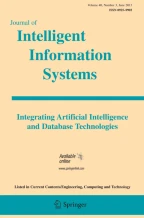Abstract
Responses to queries posed by a user of a database do not always contain the information desired. Database answers to a query, although they may be logically correct, can sometimes be misleading. Research in the area of cooperative answering for databases and deductive databases seeks to rectify these problems. We introduce a cooperative method calledrelaxation for expanding deductive database and logic programming queries. The relaxation method expands the scope of a query by relaxing the constraints implicit in the query. This allows the database to return answers related to the original query as well as the literal answers themselves. These additional answers may be of interest to the user. In section 1 we introduce the problem and method. In Section 2 we give some background on the research done in cooperative answering. Section 3 discusses the relaxation method, a potential control strategy, and uses. Section 4 looks at a semantic counterpart to this notion. In Section 5 we explore some of the control and efficiency issues. We enumerate open issues in Section 6, and conclude in Section 7.
Similar content being viewed by others
Explore related subjects
Discover the latest articles, news and stories from top researchers in related subjects.References
Aït-Kaci, H. and Nasr, R. (1986). LOGIN: A Logic Programming Language with Built-in Inheritance.Journal of Logic Programming, 3(3), 185–215.
Allen, J.F. and Perrault, C.R. (1986). Analyzing Intention in Utterances. In B.J. Grosz, K.S. Jones, and B.L. Weber (Eds.),Readings in Natural Language Processing. Morgan Kaufmann, Los Altos, CA, pp. 441–458.
Baral, C., Kraus, S., and Minker, J. (1990). Communicating between multiple knowledge based systems with different languages.Draft Proc. Int. Working Conf. Cooperative Knowledge Based Systems, (pp. 121–125), University of Keele, England.
Brachman, R.J. (1983). What IS-A Is and Isn't: An Analysis of Taxonomic Links in Semantic Networks.Computer, 16(10), 30–36.
Chakravarthy, U. (1985).Semantic Query Optimization in Deductive Databases. Ph.D. thesis, University of Maryland, Department of Computer Science.
Chen, P.P.S. (1976). The Entity-Relationship Model: Towards a Unified View of Data.ACM Transactions on Database Systems 1, 1.
Chu, W.W., Chen, Q., and Lee, R. (1990). Cooperative Query Answering via Type Abstraction Hierarchy. Tech. Rep., University of California at Los Angeles.
Cuppens, F., and Demolombe, R. (1988) Cooperative answering: a methodology to provide intellegent access to databases.Proc. Second Int. Conf. Expert Database System, (pp. 333–353).
Cuppens, F., and Demolombe, R. (1989). How to Recognize Interesting Topics to Provide Cooperative Answering.Information Systems, 14, 2, 163–173.
Enderton, H.B. (1972).A Mathematical Introduction to Logic. New York: Academic Press.
Gaasterland, T., Giuliano, M., Litcher, A., Liu, Y., and Minker, J. (1990a) Using integrity constraints to control search in knowledge base systems. Tech. Rep. UMIACS-TR-90-27, CS-TR-2416, University of Maryland, Department of Computer Science.
Gaasterland, T, Minker, J., and Rajasekar, A. (1990b) Deductive database systems and knowledge base systems.Proceedings of VIA 90. Barcelona, Spain.
Gal, A. (1988).Cooperative Responses in Deductive Databases. Ph.D. thesis, Department of Computer Science, University of Maryland.
Gal, A. and Minker, J. (1985). A natural language database interface that provides cooperative answers.Proc. Second Conf. Artif. Intell. Appl.,
Gal, A. and Minker, J. (1988). Informative and Cooperative Answers in Databases Using Integrity Constraints. In V. Dahl and P. Saint-Dizier (Eds.),Natural Language Understanding and Logic Programming, Amsterdam: North-Holland, pp. 277–300.
Gal, A. and Minker, J. (1990) Producing cooperative answers in deductive databases. In P. Saint-Dizier and S. Szpakowics (Eds.),Logic and Logic Grammar for Language Processing, L.S. Horward.
Imielinski, T. (1988). Intelligent Query Answering in Rule Based Systems. In J. Minker (Ed.),Foundations of Deductive Databases and Logic Programming, Washington, DC, Morgan Kaufman.
Janas, J.M. (1981). On the Feasaibility of Informative Answers. In H. Gallaire, J. Minker, and J. Nicolas (Eds.),Advances In Database Theory, Vol. 1, New York: Plenum Press, pp. 397–414.
Kaplan, S. (1982). Cooperative Responses from a Portable Natural Language Query System.Artificial Intelligence, 19(2), 165–187.
Kowalski, R. (1979).Logic for Problem Solving. Amsterdam: North-Holland.
Lloyd, J. (1987).Foundations of Logic Programming, 2nd ed. New York: Springer-Verlag.
McCoy, K. (1988). Reasoning on a Highlighted User Model to Respond to Misconceptions.Computational Linguistics, 14, 52–63.
McSkimin, J. (1976).The Use of Semantic Information in Deductive Question-Answering Systems. Ph.D. thesis, University of Maryland, Department of Computer Science.
McSkimin, J.R. and Minker, J. (1977). A Predicate Calculus Based Semantic Network for Question-Answering Systems. Tech. Rep., Department of Computer Science, University of Maryland.
McSkimin, J. and Minker, J. (1979). Predicate Calculus Based Semantic Network for Question-Answering Systems. In N. Findler (Ed.),Associative Networks-The Representation and Use of Knowledge in Computers, (pp. 205–238), Academic Press: New York.
Motro, A. (1986b). SEAVE: A Mechanism for Verifying User Presuppositions in Query Systems.ACM Transactions on Office Information Systems, 4, 4.
Motro, A. (1986a). Extending the relational model to support goal queries.Proc. First. Int. Workshop Expert Database Systems, (pp. 129–150), Benjamin/Cummings.
Motro, A. (1990). FLEX: A Tolerant and Cooperative User Interface to Database.IEEE Transactions on Knowledge and Data Engineering, 2, 231–245.
Nicolas, J. -M. and Yazdanian, K. (1978). Integrity Checking in Deductive Databases. In H.G.J. Minker (Ed.),Logic and Databases, New York: Plenum, pp. 325–599.
Pollack, M. (1983). Generating Expert Answers through Goal Inference. Tech. Rep., SRI International, Stanford, CA.
Reiter, R. (1988). On integrity constraints. In M. Vardi (Ed.),Proc. Second Conf. Theoretical Aspects of Reasoning and Knowledge. Morgan Kaufmann, pp. 97–111.
Reiter, R. (1990). On Asking What a Database Knows. In J.W. Lloyd (Ed.),Computational Logic: Symposium Proceedings, Springer-Verlag.
Shum, C. and Muntz, R. (1987). Implicit Representation for Extensional Answers. In L. Kershberg (Ed.),Expert Database Systems.
Sterling, L. and Shapiro, E. (1986).The Art of Prolog. MIT Press.
Wahlster, W., Marburger, H., and Busemann, A.J.S. (1983). Over-answering yes-no questions: extended responses in a NL interface to a vision system.Proc. IJCAI. Karlsruhe, Germany.
Author information
Authors and Affiliations
Rights and permissions
About this article
Cite this article
Gaasterland, T., Godfrey, P. & Minker, J. Relaxation as a platform for cooperative answering. J Intell Inf Syst 1, 293–321 (1992). https://doi.org/10.1007/BF00962922
Issue Date:
DOI: https://doi.org/10.1007/BF00962922
